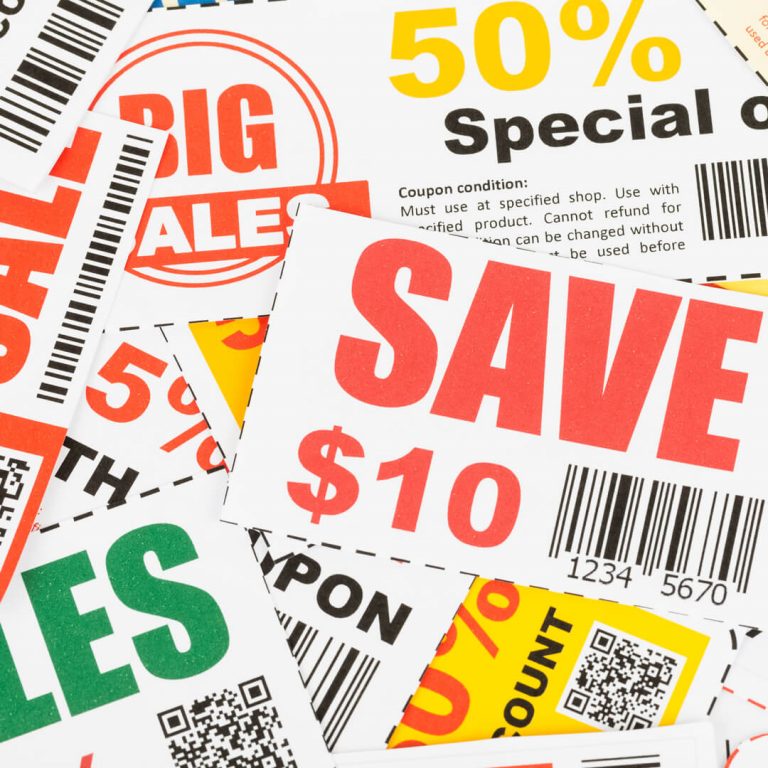“Extreme” couponing; you may have seen it on TV: It’s the ability to save thousands of dollars at supermarket and big box store cash registers.
If you’ve seen the shows, you’ll have witnessed “couponers” surrounded by stacks of newspaper inserts, cutting their coupons, and then meticulously organizing them in binders. Fast forward to the checkout portion of the show where the cashier rings up, say, $500 worth of food, cleaning supplies and personal care items. After coupons are deducted?
The shopper pays with a $10 bill and (often) gets change back.
It’s an inspiring story—and an overwhelming one, too. The time and effort it takes to acquire multiple copies of coupons (diving into dumpsters is not unheard of for extreme couponers) is staggering. Not to mention storage issues: just where do you store 13 boxes of cereal, 15 bottles of shampoo and 30 frozen dinners?
The good news is that you don’t have to be an extreme couponer to save some serious cash at the supermarket. Last year, there were 256.5 billion mass retailer coupons available to consumers in both paper and digital formats, which were redeemed for $2.7 billion in savings.
Read on for tips to get started as a couponer, and get a piece of that savings.
Tips From the Pros
If you want to accelerate your couponing game, tweak tips from the extremists to fit your lifestyle and commitment. Here are a few to get started:
1. Create your own system.
The hardcore couponers have big binders with plastic inserts to store their coupons. If you don’t plan to be an extreme couponer, you can scale the binders down to envelopes labeled by section of your store—“baking products” or “cleaning supplies” as an example—or, find a small expandable file folder at the dollar store to store your coupons.
2. Only cut the coupons for products you regularly use.
A coupon for $15 for your next purchase of a teeth-whitening kit is a great deal—but only if you’re a regular tooth whitener. Don’t buy the product just because the cost savings is significant and you think one day, down the road, you might want to try it out.
3. If you don’t want to devote too much time to your couponing efforts, think big.
While saving 25 cents on a can of soup might not seem worth the trouble, remember the more expensive items have bigger coupon values. That’s especially true of items such as diapers, laundry detergent, body wash and shampoo, razors, paper towels, and toilet paper.
Sourcing Your Coupons
Just where do you find these “coupons” we speak of?
1. Start with a trip to your local Dollar Tree.
There are more than 15,000 Dollar Tree locations, so chances are, you live near one. The store sells newspapers for $1—well off the $3 and up price of most Sunday newspapers—and they’re stuffed with all the coupons and store circulars. Depending on your local newspaper, Dollar Tree might have the newspapers on Saturday. (Whichever day you go, get there when the store opens as newspapers go fast.)
TIP:
If there is a store coupon in the circular, clip it. Most of the time, you can use store and manufacturers coupons simultaneously. It’s called coupon “stacking,” and, generally, it’s OK to use both.
2. Link your loyalty cards.
If you have favorite stores, register as a loyalty member. Download the store’s app (if they have one) or create an online account on the retailer’s website. Then, link your store loyalty card to the account and scroll through the online, in-store coupons being offered. When you buy the item and show your loyalty card, the discount is oftentimes deducted automatically. CVS, Kroger and Walgreens are among the numerous retailers that have dozens of coupons available each week. Amazon Prime members now receive special discounts at Whole Foods. Target has its Target Circle program that offers discounts in departments storewide.
TIP:
Make a list of the digital coupons you’ve saved. Without the coupon in hand, it’s easy to forget the deals you’re looking for.
3. Print online coupons.
Manufacturers often post coupons to their websites. Procter & Gamble, through its P&G Everyday website, offers printable coupons for everything from detergent to probiotics. At the Kellogg’s Family Rewards website, you can find cereal coupons, as well as savings on makeup and over-the-counter medicines. Coupons.com, CouponMom and The Krazy Coupon Lady all feature coupons you can download, print and take to your favorite store.
4. Sign up for online discount sites.
Before buying anything online, consider making a quick visit to sites like RetailMeNot, Coupon Cabin and DealNews, which either offer coupon codes or direct links to advertised deals. With these sites, you can save money on everything from car rentals to cashmere sweaters, tax software and power tools. Another weapon for your couponing arsenal is Honey, a browser extension that advertises automatically finds and applies the best coupons available to your shopping cart. And don’t forget about highly-popular cash-back sites (Rakuten, TopCashback and Ibotta), which offer cash back on purchases made at hundreds of retailers, simply by following their portal link.
You don’t have to be an extreme couponer to recognize cost savings from redeeming coupons. If your store receipt says you saved $15.33 with your coupons, put that money away in a savings account. At the end of the year, you’ll see your efforts were well rewarded.
Editor’s note: Quorum is not affiliated with any of the companies mentioned in this article and derives no benefit from these businesses for placement in this article.








Comments Section
Please note: Comments are not monitored for member servicing inquiries and will not be published. If you have a question or comment about a Quorum product or account, please visit quorumfcu.org to submit a query with our Member Service Team. Thank you.